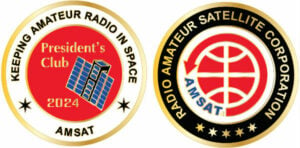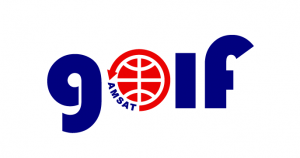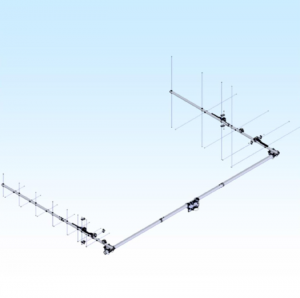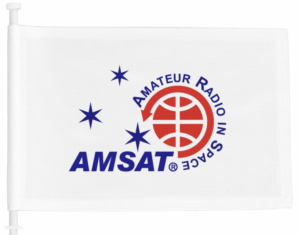In this edition:
- AMSAT Prepares for Hamvention 2024
- AMSAT VP-Engineering Reviews GOLF Satellite Development
- METEOR M2-4 Meteorology Satellite Readying for Operation
- Satellite Tracking Rotator from Security Camera System
- Changes to AMSAT-NA TLE Distribution March 22, 2024
- ARISS News
- Upcoming Satellite Operations
- Hamfests, Conventions, Maker Faires, and Other Events
- Satellite Shorts From All Over
The AMSAT News Service bulletins are a free, weekly news and information service of AMSAT, the Radio Amateur Satellite Corporation. ANS publishes news related to Amateur Radio in Space including reports on the activities of a worldwide group of Amateur Radio operators who share an active interest in designing, building, launching and communicating through analog and digital Amateur Radio satellites.
The news feed on http://www.amsat.org publishes news of Amateur Radio in Space as soon as our volunteers can post it.
Please send any amateur satellite news or reports to: ans-editor [at] amsat [dot] org.
You can sign up for free e-mail delivery of the AMSAT News Service Bulletins via the ANS List; to join this list see: https://mailman.amsat.org/postorius/lists/ans.amsat.org/
ANS-084 AMSAT News Service Weekly Bulletins
To: All RADIO AMATEURS
From: Radio Amateur Satellite Corporation
712 H Street NE, Suite 1653
Washington, DC 20002
DATE 2024 MAR 24
AMSAT Prepares for Hamvention 2024

It’s that time again. Time to start making plans to attend Hamvention 2024 from May 17-19, 2024 in Xenia, Ohio. This year’s Hamvention theme is “Expanding our Community” and AMSAT plans to do exactly that by adding new members and recruiting more volunteers. Led by AMSAT Hamvention Team Leader, Phil Smith, W1EME, preparations are well under way. AMSAT, one of the larger Hamvention exhibitors, will again occupy 1,200 square feet of space at the north end of Building 1, also known as the Maxim building. This booth area has always been ideal for AMSAT because of the ample fresh air and easy access to the outdoor satellite ground station. Exhibits will feature members of the engineering team, CubeSatSim, Beginner’s Corner, merchandise sales, Youth Initiative, software demonstrations and membership sign-ups. Also featured at this year’s booth is information and sign-ups for the revitalized AMSAT Ambassador program.
AMSAT will host its annual AMSAT Forum on Saturday from 1:10 to 2:10 in Room 2. Moderated by Phil Smith, W1EME, Robert Bankston KE4AL, AMSAT President, will highlight recent activities within AMSAT and discuss some of our challenges, accomplishments, projects, and any late breaking news. AMSAT Engineering Program: Jerry Buxton, N0JY, AMSAT Vice President for Engineering, will talk about the Current and upcoming satellite missions. AMSAT Education: Alan Johnston, KU2Y, AMSAT Vice President Education Relations will talk about the AMSAT CubeSat Simulator. AMSAT Operations: Drew Glasbrenner, KO4MA, Vice President Operations, will discuss current satellites and operations. AMSAT Development: Frank Karnauskas, N1UW, Vice President of AMSAT Development, will report on AMSAT Youth Initiative and its features.
Another attraction will be the 15th annual AMSAT/TAPR Banquet on Friday at 18:30 EDT. This dinner is always a highlight of the TAPR (Tucson Amateur Packet Radio) and AMSAT (Radio Amateur Satellite Corp.) activities during the Dayton Hamvention. This year’s banquet speaker will be Bill Reed, NX5R, AMSAT Volunteer Engineer, who will highlight the forthcoming PACSAT digital communications payload.
The 2023 Hamvention attendance was 33,861, which is more than 2,000 greater than 2022 and even surpassed the previous pre-pandemic attendance record at the Greene County Fairgrounds and Expo Center of 32,472. This year’s attendance is expected to be another record breaker. As a bonus, this year’s Hamvention will also be the site for the ARRL 2024 National Convention.
If you are planning on attending this year’s Hamvention, please consider volunteering to help staff the AMSAT booth for an hour or so. Please send an email to volunteer [at] amsat [dot] org if you think you can help.
For complete information on Hamvention 2024, go to https://hamvention.org/.
[ANS thanks AMSAT for the above information.]

The 2024 AMSAT President’s Club coins are here now!
Join the AMSAT President’s Club today and help
Keep Amateur Radio in Space!
https://www.amsat.org/join-the-amsat-presidents-club/
AMSAT VP-Engineering Reviews GOLF Satellite Development

Recently AMSAT News Service had the opportunity to interview Jerry Buxton, N0JY, AMSAT Vice President of Engineering, about the GOLF satellites that are currently in development.
ANS: Jerry, the AMSAT engineering team is developing the GOLF (Greater Orbit, larger Footprint) satellites. What is the idea behind these satellites and the kind of functionality that will be added?
JB: “Our original thought was for GOLF is to teach us how to go to Highly Elliptical Orbit (HEO.) Higher orbits have greater challenges than the satellites for LEO orbits we have built most recently. These are challenges like the higher radiation environment that the satellite must endure and controlling the satellite at higher altitudes.
“We’ve had a significant additional requirement that has been added since GOLF was originally conceived. We must be able to deorbit the satellite on command. This is a pending FCC regulation. It is also likely that we will be required to move the satellite to avoid orbital debris in the future. To do this we have to be able to accurately know where the satellite is which requires a Global Navigation Satellite System (GNSS), which direction it is pointing which requires adding an Attitude Determination Control System (ADCS), and have a propulsion system to move it. This is not trivial.
“Of course, we want to add more and more capabilities which require more power.
“So, the purpose of the GOLF satellites is technology development, but they will have radios on board. Once they are up and we have proven the technology we will have another satellite that amateur radios operators can use.”
ANS: “What is the advantage of higher orbits?”
JB: “Most of our current satellites are LEO, so we have about a 10 to 15-minute window to work the satellite. With higher orbits, the satellites will have a larger footprint (the signal will cover a larger area of the earth) and will be available or visible for longer periods of time.
ANS: “Could you tell us a little more about how GOLF is being developed?”
JB: “We will design and build the systems if we can, and we will acquire (buy) the functionality if need to. We are also using a stepped approach to capability development. We may fly the Attitude Determination Control System (ADCS) on the first satellite, add the propulsion system on the next satellite and so on.
ANS: “Interesting! What else makes GOLF different from our previous satellites?”
JB: “GOLF-TEE will have a new 3U space frame with deployable solar panels, which will flop open and lock into place. The solar cell system is an in-house design. It will have 14 cells on the satellite space frame and 28 on the deployable solar panels for a total of 42 cells, a significant increase in available power.
“GOLF will have a radiation tolerant IHU (Internal Housekeeping Unit, or on-board computer.)
It uses an automotive grade 32 bit ARM processor which has two processors. One is the primary. If one locks up the other takes over. The computer cores are in different areas of the chip and are at 90 degrees to each other, which lowers the likelihood of radiation affecting both processors.
“We’re adding microwave bands with a 10 GHz downlink experiment for increased data speed, that can also be used as a transponder downlink. This is a purchased radio. It has been a little bit of a challenge to fit the SDR into GOLF because it doesn’t fit the normal layout.
“GOLF will be much more complex than the FOX satellites. This complexity will increase the cost. This is because of the added capability the engineering team is developing like the additional solar panels as well as the selection and integration of purchased items like the ADCS or the 10 GHZ SDR radio.”
ANS: “Wow, the GOLF satellites will be a give us exciting new capabilities! When will they be launched?”
JB: “The first is GOLF-TEE, which will be ready for launch in Q4 of 2025. GOLF-1 will be ready follow in Q4 of 2026. We should have some data and lessons learned from GOLF-TEE by then.
“Here is a little more detail on the launch; GOLF-TEE and GOLF-1 have been approved by NASA as sound concepts and eligible for the ELaNa program. This program will pay for launch up to $300k of launch cost (covers everything up to a 3U satellite to LEO) and they will look for a launch that we can ride on. (We don’t get to choose just when we launch.) A launch is not a guaranteed, but they always have found a ride for us.”
ANS: “Thank you, Jerry, for helping us understand these important new satellites!”
[ANS thanks Jerry Buxton, N0JY, and Mark Blackwood, KI5AXK, for the above information.]
METEOR M2-4 Meteorology Satellite Readying for Operation

Low earth orbit meteorology satellites are usually overlooked as an easy way to get newcomers involved in amateur satellites. They transmit with high power and gain antennas so they are easily received with a simple dipole antenna and a $30 RTL-SDR dongle that plug into a computer that most everyone owns. They are always on and transmit data that is actually fun and usable: very clear pictures of ones’ own locale that is easily decoded with free software.
From this first experience, it is a simple jump to tracking and copying the ARISS voice and APRS repeaters, and from there getting a Technician class license and inexpensive handheld.
In addition to the NOAA low earth orbit polar meteorology satellites, the Russian METEOR M2-4 was recently added on February 29, 2024. It was launched into a 800km sun-synchronous orbit with a 98 degree inclination from the Vostochny Cosmodrome aboard a Soyuz 2 rocket.
Having achieved orbit, it is currently undergoing testing and calibration. There is currently no information when setup will be completed, but it did take several months for NOAA to get the NOAA-21 satellite running. Once it is functioning it will begin transmitting its low-rate picture transmission (LRPT) imagery on 137.1 MHz and/or 137.9 MHz. The antennas are right-hand circular polarization but are easy received with a home-made three-element yagi or even a simple dipole.
Complete information on suitable SDR receivers, and free receiving and decoding software can be found at rtl-sdr.com. A simple You Tube search on the topic will also provide you with enough demonstration videos to help get you started. More information at https://www.rtl-sdr.com/.
[ANS thanks rtl-sdr.com for the above information.]

Need New Satellite Antennas?
Purchase M2 Antennas LEO-Packs from the AMSAT Store.
When you purchase through AMSAT, a portion of the proceeds
goes towards Keeping Amateur Radio in Space!
https://www.amsat.org/shop/
Satellite Tracking Rotator from Security Camera System

No stranger to AMSAT publications, Gabe Emerson, KL1FI, publisher of saveitforparts.com is at it again. This month Gabe has posted a 24-minute video on how to use parts from an old security pan-tilt camera mount to build an az-el satellite rotator.
The rotator motors are controlled by software based on the Australian School Amateur Radio Club Network (SARKNET) Rotator Mark I Arduino code. The software can be run on either an Arduino device or on a PC laptop. Gpredict is used in this example to track the satellites.
Gabe uses the rotator to steer a small dish but it looks strong enough to handle a lightweight yagi such as an Arrow or Elk if suitably counterweighted.
Even if you aren’t interested in building this az-el rotator, Gabe’s video is a fascinating look at how an inventive mind and resourceful scrounger can make something actually useful. Ham radio as it should be! More information at https://www.rtl-sdr.com/.
[ANS again thanks rtl-sdr.com for the above information.]
[ANS thanks _ for the above information.]

Want to Fly the Colors on Your Own Grid Expedition?
Get your AMSAT Car Flag and other neat stuff
from our Zazzle Store!
25% of the purchase price of each product goes
towards Keeping Amateur Radio in Space!
https://www.zazzle.com/amsat_gear
Changes to AMSAT-NA TLE Distribution for March 22, 2024
Two Line Elements or TLEs, often referred to as Keplerian elements or keps in the amateur community, are the inputs to the SGP4 standard mathematical model of spacecraft orbits used by most amateur tracking programs. Weekly updates are completely adequate for most amateur satellites. Elements in the TLE bulletin files are updated daily. TLE bulletin files are updated to add or remove satellites as necessary Thursday evenings around 2300 UTC, or more frequently if new high interest satellites are launched. More information may be found at https://www.amsat.org/keplerian-elements-resources/
The following satellite has been added to this week’s AMSAT-NA TLE Distribution:
SONATE-2 – NORAD Cat ID 59112 Downlinks on 437.025 MHz, 145.825 MHz, 145.840 MHz and 145.880 MHz have been coordinated by the IARU. Thanks to Nico Janssen, PA0DLO, for the identification.
The following satellite has been removed from this week’s AMSAT-NA TLE distribution:
BeliefSat-0 NORAD Cat ID 58695 End of mission.
This mission was interesting as BeliefSat-0 is not a free flying satellite. Instead it is a “hosted payload” on a larger platform, in this case the spent upper stage of an Indian launch vehicle. The stage was modified such that it included solar panels and attitude control, so BeliefSat 0 and other payloads were designed to simply bolt on and plug in to a regulated power source. See https://www.isro.gov.in/POEM-3_Mission_achieves_Payload_objectives.html for details.
While BeliefSat-0 and its host POEM-3 remain in orbit for now, it appears that BeliefSat-0 has been shut down as there have not been any successful observations of it in SatNogs for several weeks. POEM-3 will reenter within the next few weeks “leaving zero debris in space” according to the Indian Space Resource Organization.
[ANS thanks Joe Fitzgerald, KM1P, AMSAT Orbital Elements Manager for the above information.]
ARISS NEWS

Amateurs and others around the world may listen in on contacts between amateurs operating in schools and allowing students to interact with astronauts and cosmonauts aboard the International Space Station. The downlink frequency on which to listen is 145.800 MHz worldwide.
Completed Contacts
+ Second Chance School of Orestiada, Orestiada, Greece, telebridge via VK4KHZ.
The ISS callsign was NA1SS.
The crewmember was Loral O’Hara, KI5TOM, and Mike Barratt. KD5MIJ (Observing).
The Moderator was William Marchant KW4WZ.
The ARISS mentor is IKØWGF
Contact was successful on Wednesday, March 20, 2024 at 17:45 UTC.
Upcoming Contacts
+ Amur State University, Blagoveshchensk, Russia, direct via TBD.
The ISS callsign is presently scheduled to be RSØISS.
The scheduled crewmember is Aleksandr Grebyonkin, RZ3DSE.
The ARISS mentor is Energia ARC, RV3DR.
Contact is go for Monday March 25, 2024 at 08:40 UTC.
+ St. John’s School Authority, St. John’s, NL, Canada, telebridge via ON4ISS.
The ISS callsign is presently scheduled to be OR4ISS.
The scheduled crewmember is Loral O’Hara, KI5TOM.
The Moderator is scheduled to be Brian Jackson, VE6JBJ.
The ARISS mentor is Brian Jackson, VE6JBJ.
Contact is go for: Monday, March 25, 2024 at 16:24 UTC.
Watch for Livestream at https://www.youtube.com/@fidlerville
+ Kursk, Russia, direct via TBD.
The ISS callsign is presently scheduled to be RSØISS.
The scheduled crewmember is Aleksandr Grebyonkin, RZ3DSE.
The ARISS mentor is Energia ARC, RV3DR.
Contact is go for Wednesday, March 27, 2024 at 14:55 UTC.
+ Ufa, Russia, direct via TBD.
The ISS callsign is presently scheduled to be RSØISS.
The scheduled crewmember is Marina Vasilevskaya.
The ARISS mentor is Energia ARC, RV3DR.
Contact is go for Friday, March 29, 2024 at 16:20 UTC.
The Crossband Repeater
(145.990 MHz up {PL 67} & 437.800 MHz down)
Continues to be active.
Note: Powering off for Soyuz docking on March 25. OFF March 24 about TBD UTC. ON March 26 about TBD UTC.
If any crewmember is so inclined, all they have to do is pick up the microphone, raise the volume up, and talk on the crossband repeater. So give a listen, you just never know.
Packet System is also active .
(145.825 MHz up & down)
Currently active.
Note: Powering off for Soyuz docking on March 25. OFF March 24 about TBD UTC. ON March 26 about TBD UTC.
Note, all times are approximate. It is recommended that you do your own orbital prediction or start listening about 10 minutes before the listed time.
The latest information on the operation mode can be found at https://www.ariss.org/current-status-of-iss-stations.html
The latest list of frequencies in use can be found at https://www.ariss.org/contact-the-iss.html
[ANS thanks Charlie Sufana, AJ9N, one of the ARISS operation team mentors for the above information.]
Upcoming Satellite Operations
- Paradise Island, C6A
Jay Stephenson, WA1JAY, visits from March 15 to April 2. QRV as C6A/WA1JAY on HF (SSB, FT4/8) and via FM satellites. QSL via ClubLog OQRS, LoTW. - NOIRMOUTIER ISLAND, TM4
F4DXV Jerome (@F4DXV) and EA4NF Philippe (@EA4NF_SAT) announce that they will be actívating Noirmoutier island EU-064 IN86 from April 1 to 4, 2024 with the special callsign TM4J. This International DXpedition is the first 100% SAT from this French island. Operating on LEO (FM+SSB), GEO (QO-100) and MEO (GREENCUBE IO-117). Updates are available on @TM4J_SAT. - Austral Islands, FO
Haru, JA1XGI, will be QRV as TX5XG from Raivavae, IOTA OC-114, from March 27 to April 3. Activity will be on 160 to 6 meters using CW, SSB and various digital modes. This includes being active on Satellite IO-117. QSL via LoTW. [ANS thanks ARRL DX news.] - Curacao, PJ2
Andreas, DK5ON, is QRV as PJ2/DK5ON until March 27. Activity is on 80 to 6 meters, and possibly 160 meters, using CW, SSB, FT8, and FT4. This includes being active on various Satellites. QSL to home call. [ANS thanks ARRL DX news.]
A growing number of satellite rovers are currently engaged in sharing their grid square activations on https://hams.at. By visiting the website, you gain easy access to comprehensive information about the operators responsible for activating specific grid squares. Additionally, you have the ability to assess the match score between yourself and a particular rover for a given pass, while also being able to identify the upcoming satellite passes that are accessible from your location.
[ANS thanks Ian Parsons, K5ZM, AMSAT Rover Page Manager, for the above information.]
Hamfests, Conventions, Maker Faires, and Other Events
AMSAT Ambassadors provide presentations, demonstrate communicating through amateur satellites, and host information tables at club meetings, hamfests, conventions, maker faires, and other events.
- Raleigh NC Hamfest
Saturday, 6 April 2024
Jim Graham Building, NC State Fairgrounds
https://www.rarsfest.org/ - 2024 CubeSat Developer’s Workshop
Tuesday April 23 – Thursday April 25
Cal Poly, San Luis Obispo, CA
https://www.cubesatdw.org/ - Dayton Hamvention 2024
Friday May 17 – Sunday May 19
Greene County Fairgrounds and Expo Center
120 Fairground Road
Xenia, OH 45385
https://hamvention.org
AMSAT Ambassador Clint Bradford, K6LCS, says, “Think a 75-minute presentation on “working the easy satellites” would be appropriate for your club or event? Let me know by emailing me at k6lcsclint (at) gmail (dot) com or calling me at 909-999-SATS (7287)!” Clint has NEVER given the exact same show twice: EACH of the 150+ presentations so far has been customized/tailored to their audiences.
Satellite Shorts From All Over
+ Active satellite operator Alan Bowker, WA6DNR, became a silent key on March 8. Alan was one of the first Broadcasting majors at the University of Wyoming and began his career at KATI radio in Casper. He later worked for KCBS-FM and KGO TV in California. As microcomputers emerged in the industry, Alan evolved into a computer technologist, working at Northstar Computers, Fantasy Records, and Dolby Laboratories. During the winter months of 1983 and 1984, he spent time in London as computer consultant to Hollywood film filmmaker, Stanley Kubrick. In retirement, he turned into a travel photographer, touring worldwide and documenting his experiences in still photos and video. First licensed in 1966, he was a consistent voice on RS-44 and an avid experimenter on IO-117 and other digital modes from CM87 in northern California. He earned AMSAT GridMaster Award #62 of which he was very proud, while grateful to the many rovers who worked hard to make that happen for him. We will miss hearing Alan on the birds! [ANS thanks Mark Johns, K0JM for the above information.]
+ With the spectacular launch of SpaceX-30 on March 21, 2024, the HamTV system is now back on it’s on its way to the ISS. Although it is not expected that the HamTV equipment will be activated for at least a few weeks, the British Amateur Television Club (BAT) has created a new wiki page which gives a lot of information on how to receive, decode and display the DATV signals from the ISS. See https://wiki.batc.org.uk/HAMTV_from_the_ISS; there is also a discussion channel available on the site. [ANS thanks Graham Shirville, G3VZV for the above information.]
+ The Saudi Amateur Radio Society – Satellite and Communications Committee has established AMSAT-HZ as the amateur satellite society in Saudi Arabia. Their website, currently under construction, is https://amsat-hz.org/. AMSAT congratulates AMSAT-HZ on their establishment and wishes them the best of luck in their endeavors. [ANS thanks Abdul Alshahrani, HZ1DG for the above information.]
+ Tom Van den Bon, ZR6TG has been toying with this idea of adding a “Widget” to his Icom IC-9700. Playing with satellites requires various kinds of software that requires a fully fledged PC connected to the radio for tracking the satellite, controlling the rotator and automatically adjusting for Doppler effect. While all of that software works perfectly fine, Tom always wondered if there wasn’t a simpler solution which is always available and ready at the radio. Tom says, “I know there are a few satellite “controllers” available that allow you to do something similar, but I felt that those are either too specific (i.e., only one radio and one rotator) or was lacking some features. My idea around the Satellite Tracking widget is to try and combine everything I need in a single small display.” See Tom’s project report on his Raspberry Pi-based widget based at https://tinyurl.com/ANS-084-Widget. [ANS thanks Tom Van den Bon, ZR6TG for the above information.]
Join AMSAT today at https://launch.amsat.org/
In addition to regular membership, AMSAT offers membership to:
Societies (a recognized group, clubs or organization).
Primary and secondary school students are eligible for membership at one-half the standard yearly rate.
Post-secondary school students enrolled in at least half time status shall be eligible for the student rate for a maximum of 6 post-secondary years in this status.
Memberships are available for annual and lifetime terms.
Contact info [at] amsat.org for additional membership information.
73 and remember to help Keep Amateur Radio in Space!
This week’s ANS Editor, Frank Karnauskas, N1UW
n1uw [at] amsat [dot] org